Kobe Bryant on the Kobe X and how sneakers tell the story of his career

LOS ANGELES -- Every sneaker has a story. Whether emotion is woven into the design or history is crystallized by a special game-worn pair, these stories matter to a basketball star concerned with his legacy. These stories matter to Kobe Bryant.
That’s why Kobe laces up a new pair of kicks before every game, stashing away the old ones. Some are tucked inside the bowels of the Lakers’ practice facility and others that carry the most cherished stories secured in a vault. Every shoe, every emotion of his 19-year career cataloged by the shoes that commemorated the moment.
Speaking to SI.com earlier this month in Los Angeles ahead of the launch of his 10th signature shoe with Nike, the Kobe X, Bryant said that while his latest shoe gives us a snapshot of where he is right now, every shoe he’s helped create tells a story and represents as an important chapter of his evolution.
• MORE NBA: SI.com Sneaker Hub | Midseason awards| Grading all 30 teams
“When I first started the process working with Nike, I told them about my vision and my idea to look 20 years from now and literally pick up (any) product and understand what that represents,” Bryant said. “Some products are darker than others, a snapshot of a moment of time. You can almost look at that shoe and pull out a certain emotion. That is what I was going through at that time.
“What I’ve done in the latter stages of my career is become more transparent. As I’ve evolved and continue to grow, I have become more comfortable to let people in and see me as a person.”
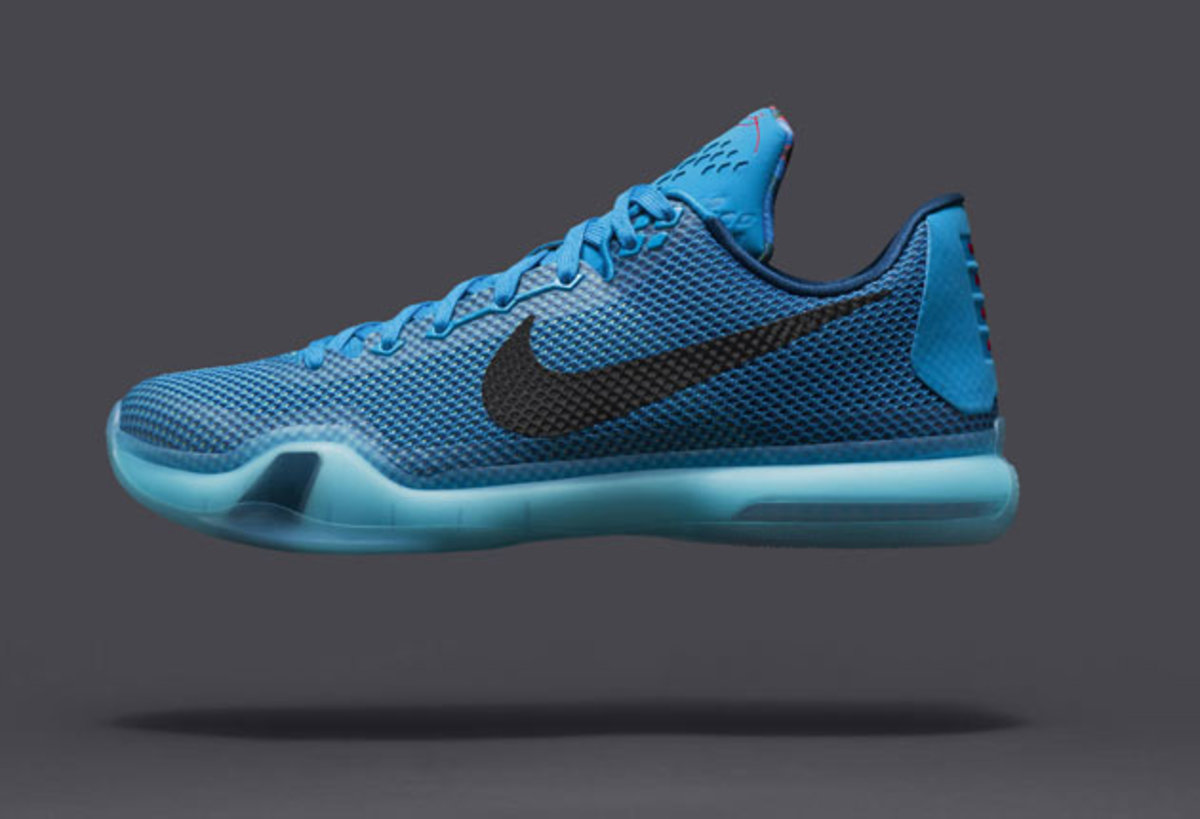
In 2005, during Kobe's early stages as a designer and the prime of his career, we saw a clean style focused on technology. But by 2008, the Lakers star was ready to challenge the norm in basketball design and opt for a low-cut shoe for more lightweight movement. “I wanted a low shoe,” he said, “I believed I could perform better.”
Critics said the low-cut wouldn’t work. “The truth of the matter is I stepped out on the court and scored 60 points and everybody believed in the s---.”
• NEW SHOE RELEASES: Carmelo Anthony | Stephen Curry | Damian Lillard
With the help of Eric Avar, the Nike designer behind all of Kobe’s signature shoes from the past decade, Kobe brought the low-top style to the forefront in 2008. He also introduced a little extra edge on his look that would quickly catch on: the Black Mamba persona.
“It has become an attitude,” Bryant said while wearing a white sweatshirt with a Mamba print down the sleeves. “It gives you a cover to be able to go out and kick ass. No, that wasn’t me, that was my Mamba personality. It is like a hall pass.”
Kobe Bryant will be back next season, but will it be with the Lakers?
The Mamba print played major roles in the look of Kobe’s recent shoes, but Avar turned it into a “discovery” element in the simplified design of the Kobe X, appearing only under the tongue of the brand-new model.
While Kobe underwent surgery to repair a torn rotator cuff this week, it was his torn Achilles that served as motivation for his last shoe, the Kobe 9. After a grueling and painful rehabilitation process, Bryant added nine red stitches to the back of his shoe to represent the nine stitches left on his leg from his Achilles surgery. Kobe said the stitches served as a reminder to what he had to go through to get back on the court. It's a story that he continued with the Kobe X, which bear four red stitches on the heel, paying homage to the four feet of thread doctors used to repair Bryant's Achilles.
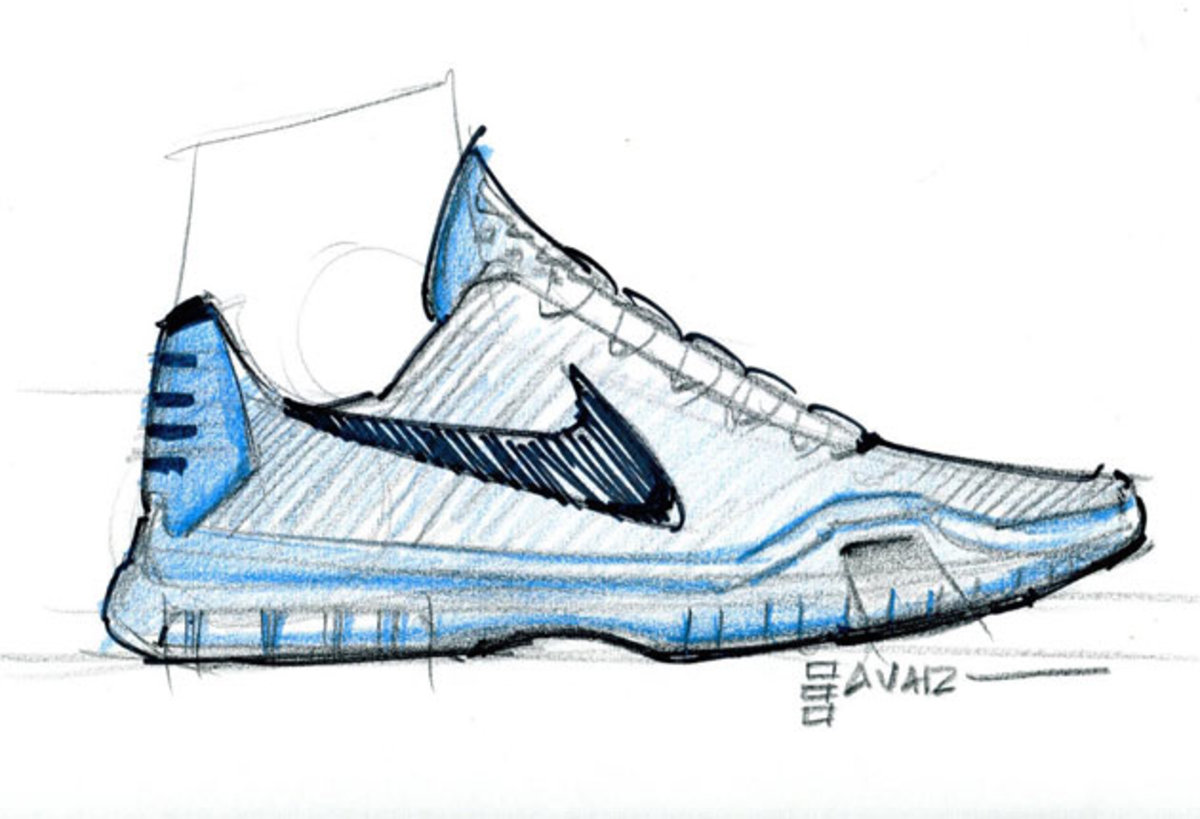
But 2015’s emotional snapshot proves much larger than stitching. Clarity. Transparency. Not just as an athlete, but a person. That’s how Kobe tells it.
“As I’ve aged, I’ve become more and more comfortable being able to just really open up,” he said. “It is like the governor disappears and I wanted to reflect that in the shoe. I wanted to be able to communicate that.”
• MORE NBA: Kobe Bryant: Reflections on a cold-blooded career (10.16.13)
To create that look -- a process in which Kobe brings unrivaled intensity to, says Avar -- Bryant borrowed inspiration from the clear back of the first Mac computer. Bryant and Avar built a transparent outsole, adding in design and technology to fill out a transparent Kobe story.
The first of five colorways in the Kobe X collection is the "5 AM FLIGHT" (release date Feb. 7) a design that possesses transparent soles and stories.
“It means commitment,” Kobe said. “Waking up at 5 a.m. to do anything is hard. But I get up at 5 a.m. and I train. I can get more training if I start earlier.”
Potentially the boldest design move comes in a large gold X on the underside of the heel, pronouncing the 10th edition of the sneaker. Kobe’s signature written in gold across the X accentuates the color.
History of Kobe Bryant's Signature Sneakers
KB8 (adidas)
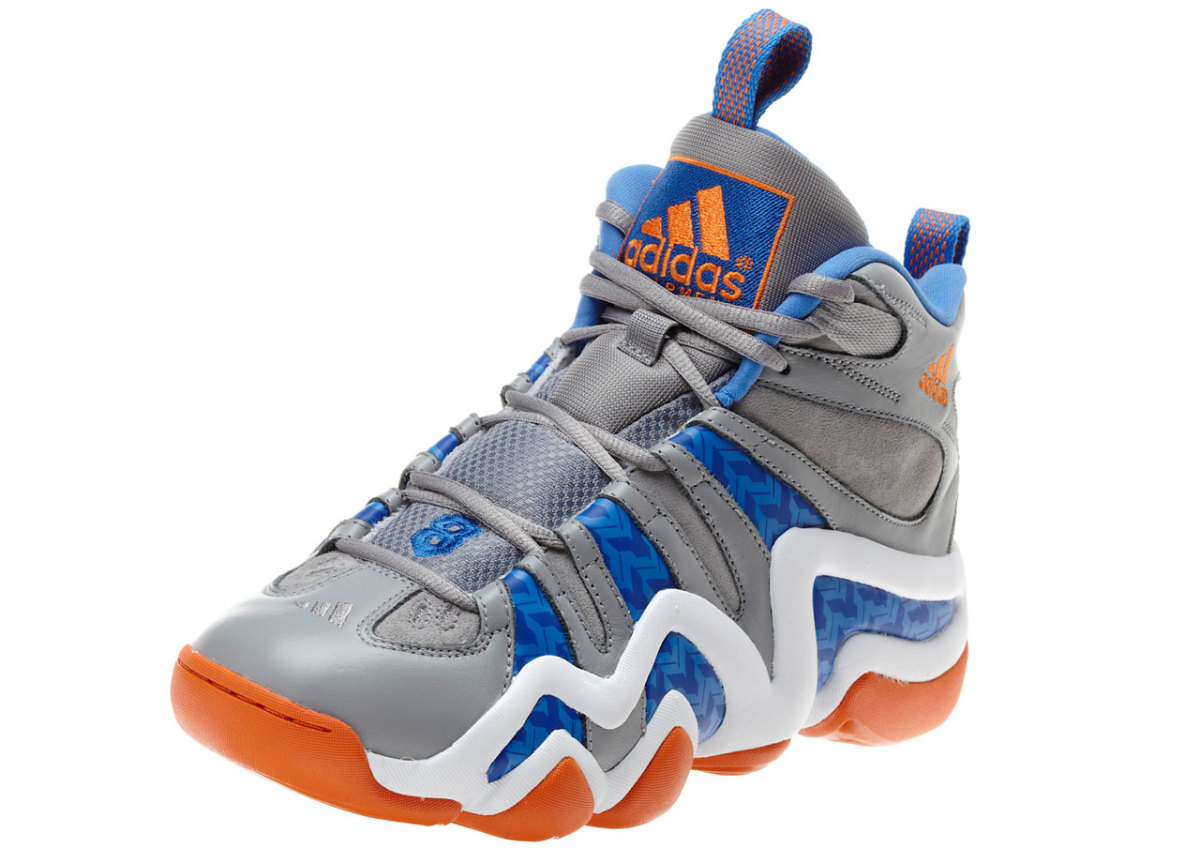
Drafted straight out of high school, Kobe started his rookie season in the adidas EQT Elevation, but his first signature shoe came in 1997 with the adidas release of the KB8, now known as the Crazy 8. With technology said to capture the natural motion of the shoe, the first signature Kobe style had bold lines.
KB8 II (adidas)
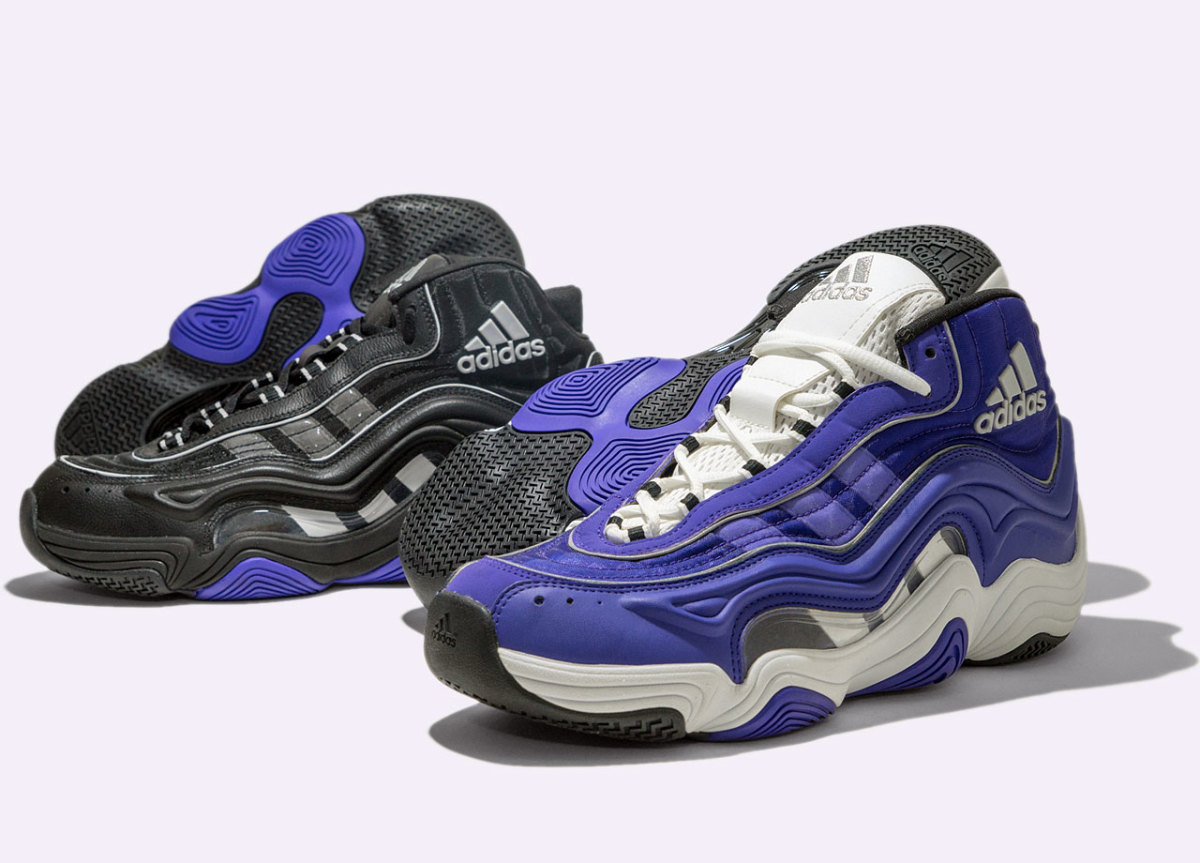
While some of the original boldness was played down, nothing quite says ‘90s style as the 1998-released second signature for Kobe. While known as the Crazy 2, the exaggerated features included a wave-shaped upper molding, see-through mesh to highlight the three stripe logo and a herringbone outsole pattern.
KB8 III (adidas)
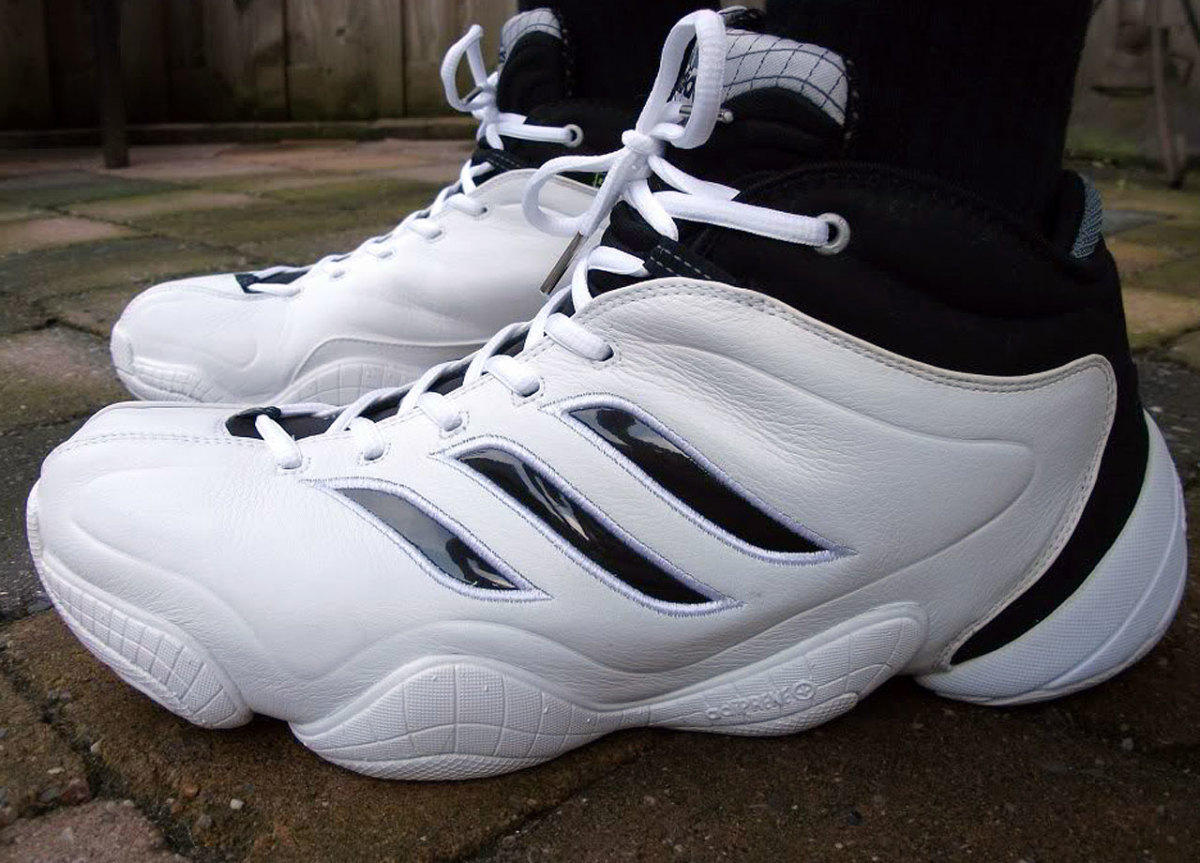
Think of the Crazy 8 and Crazy 2 slightly toned down, but with a bit more angularity. Released in 1999, the adidas three stripes take on a new look on the side, while the wavy look we saw from the second Kobe shoe remains in the third installment. But get ready, what adidas did next rode no trending wave.
The Kobe (adidas)
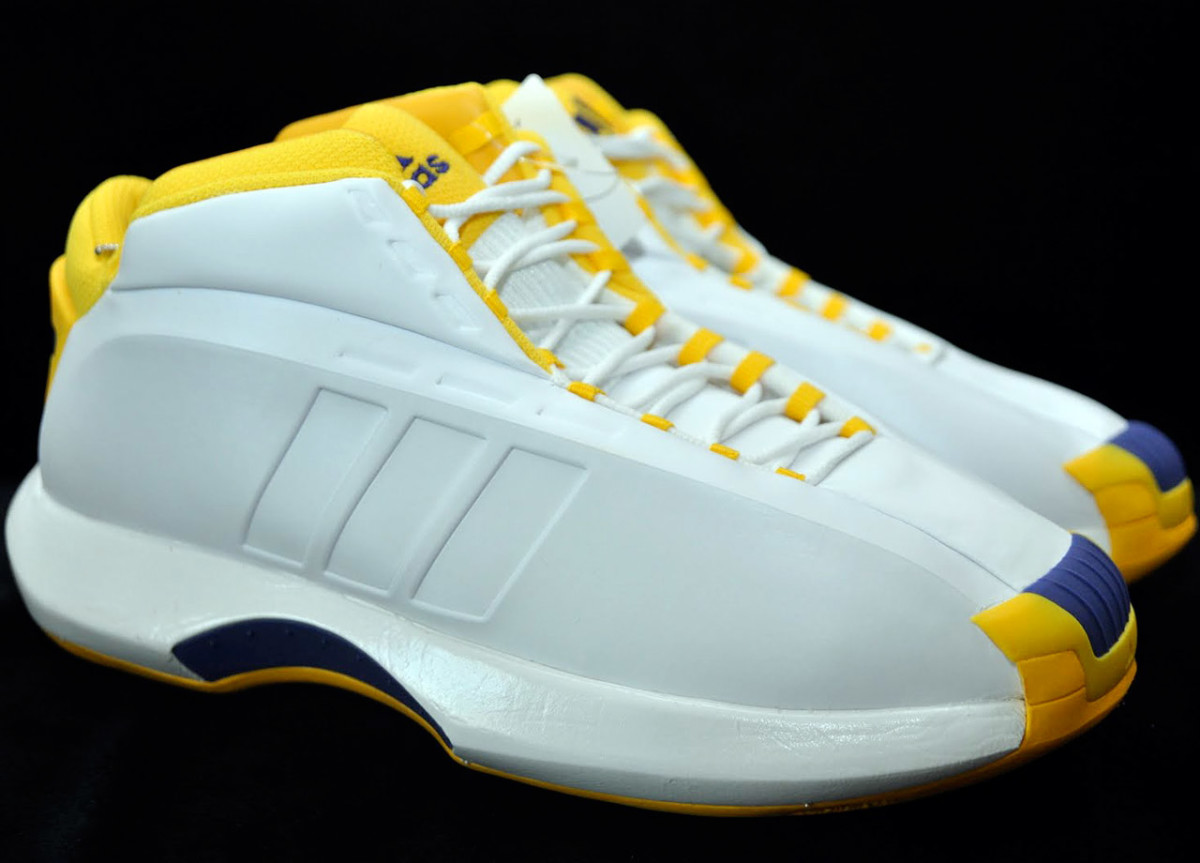
The year was 2000. It was time to return to the moon. The Kobe, later dubbed the Crazy 1, had a molded upper on his signature that was from a future we’ve never gotten to (or a past we never really wanted to see). The shoe wasn’t all moon-related, though, with some style touches that gave it a bit of sleekness. Kobe successfully wore the shoes, which is a lot more than we can say about what happened next.
The Kobe Two (adidas)
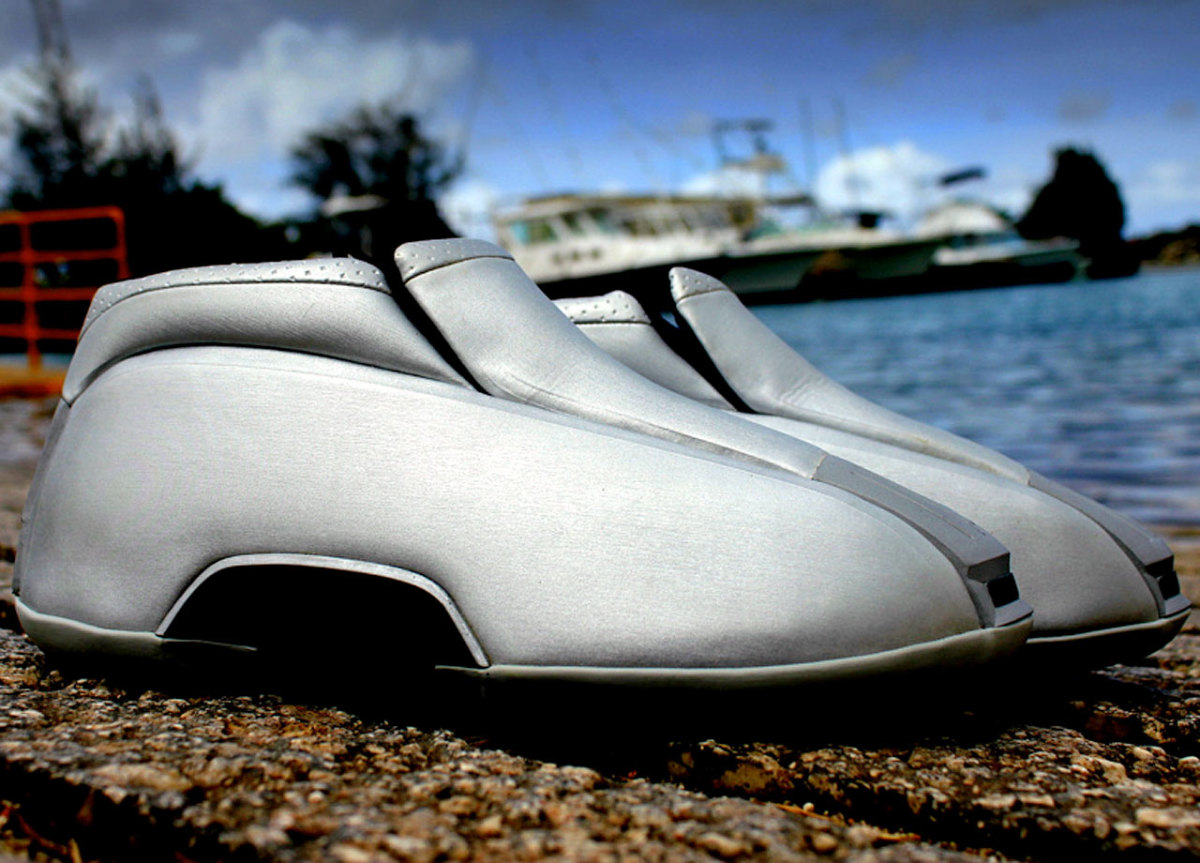
Space shoes take two. That’s what happened when adidas rolled out the 2001 release of the Kobe space installment. These were as blocky and space-related as possible and Kobe stuck with The Kobe.
Zoom Kobe I (Nike)
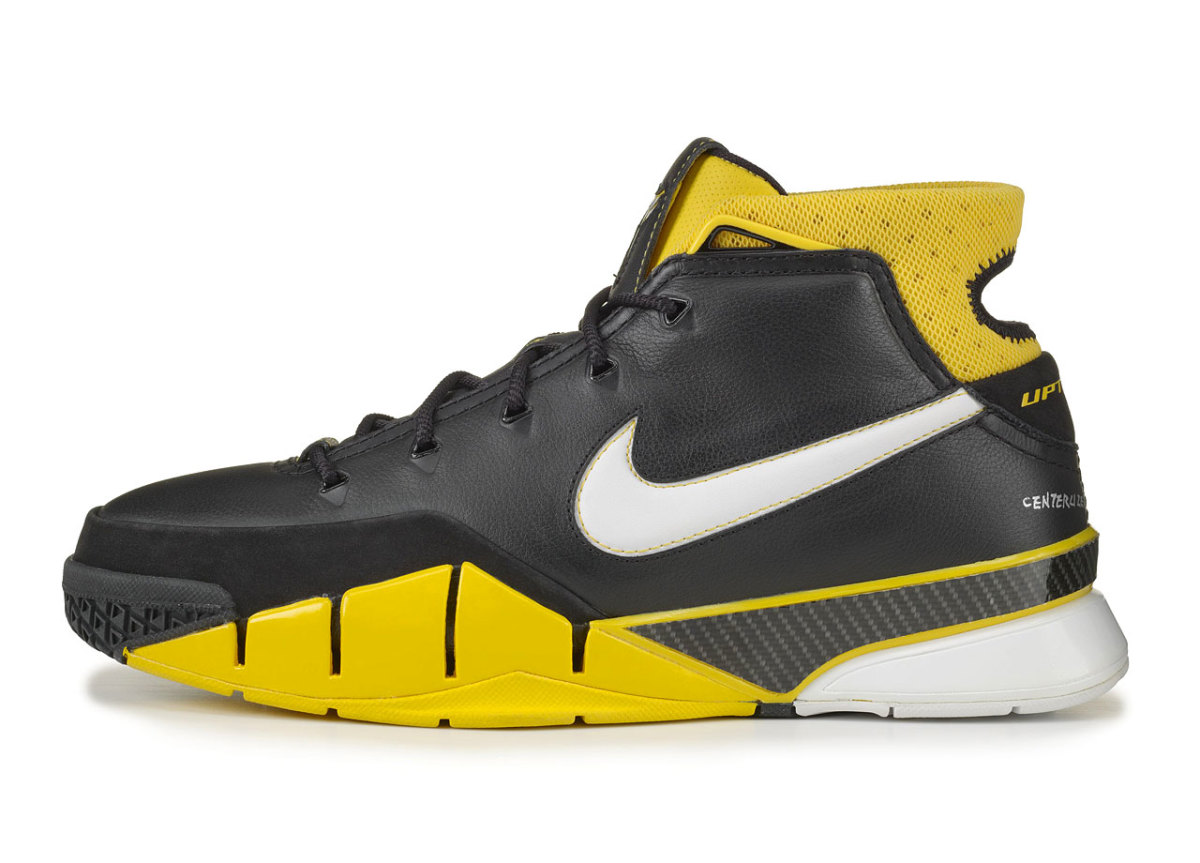
A prolonged switch from adidas to Nike (and social and legal issues off the court) kept the first signature Nike shoe for Kobe from the sneaker world until the 2005 release of a full-grain leather shoe. A full-length carbon fiber spring plate was key technology aimed at lightweight stability.
Zoom Kobe II (Nike)
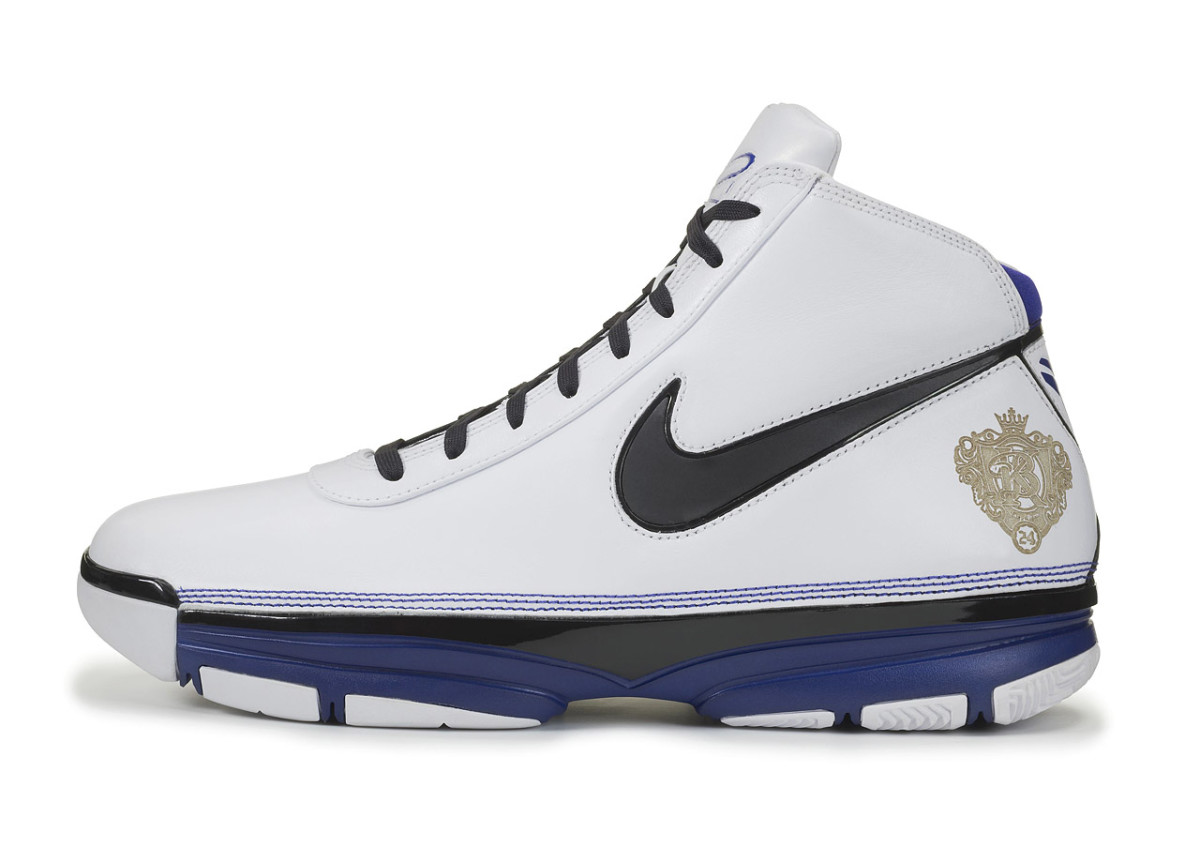
The second Kobe signature from Nike took on a bit more style, adding in patterns and straps, but keeping the overall silhouette of the signature line relatively in tact. This signature shoe debuted in 2007.
Zoom Kobe III (Nike)
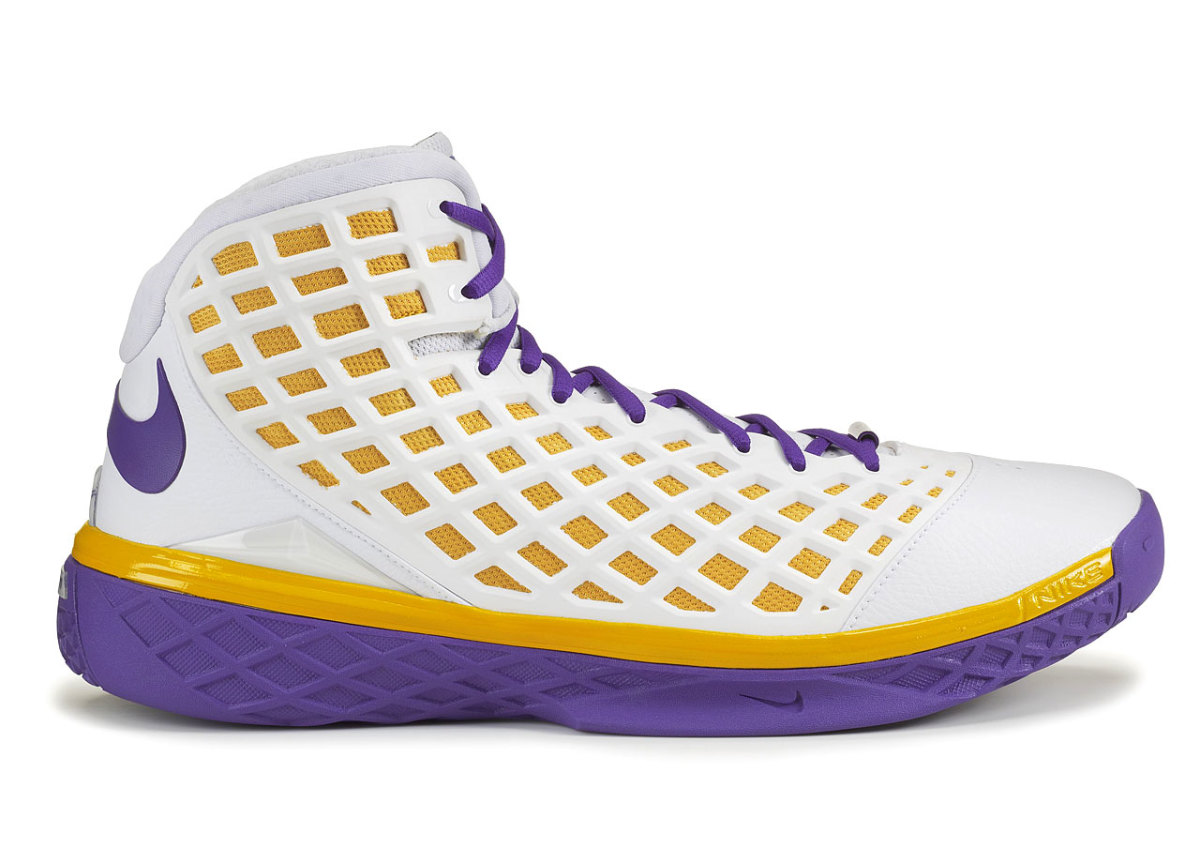
In 2008, Nike gave us an upper featuring a net shape for support of the foot and the opportunity for Nike to start playing with color and aesthetics. The carbon fiber plate continued through and a full-length Zoom Air unit in the midsole aimed to allow for cushioned movement.
Zoom Kobe IV (Nike)
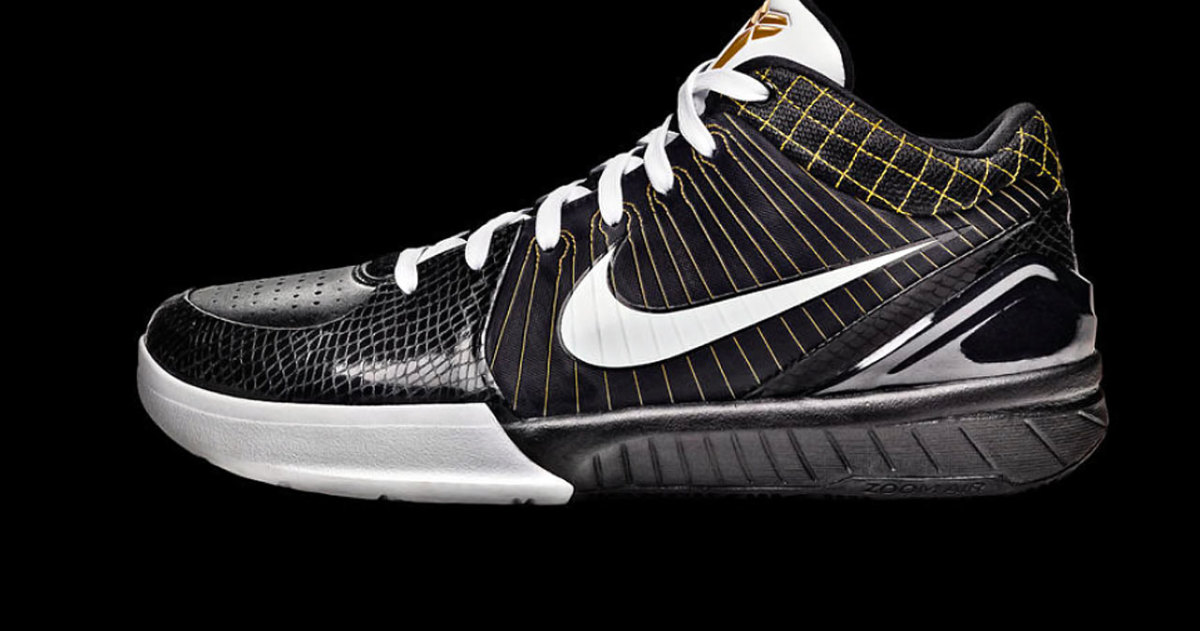
In 2008 things started getting a little different for Kobe and Nike. The 2008 release of the Kobe IV added a low-cut profile that still aimed for support. Inspired by soccer -- a sport not clamoring for high-top shoes despite the same constant starting and stopping -- this signature version was a Kobe push to provide a low-cut basketball shoe. Using Flywire, which also defined the aesthetic, for the first time in a Kobe shoe, the technology of a low-cut shoe was there. And the Black Mamba persona inspired the look of it all.
Zoom Kobe V (Nike)
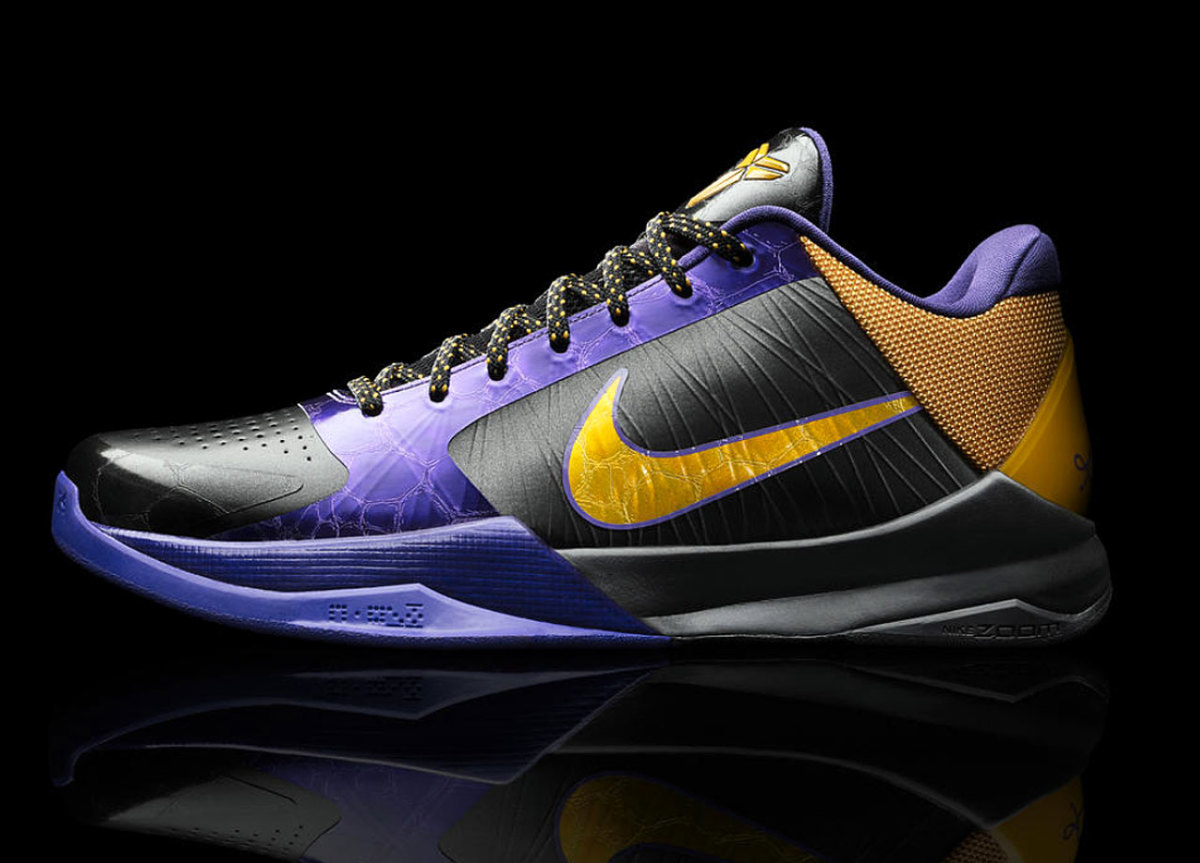
In 2009, Kobe went even lower and lighter than he did with the IV the year before. By further modifying the arch and heel of the shoe, the V decoupled the heel to help keep the shoe on the floor. A glass/carbon fiber plate in the mid-foot helps with control and rigidity. The new technologies underfoot were supported by stronger Flywire, heat welded bonding of the upper and an injected cushioning system.
Zoom Kobe VI
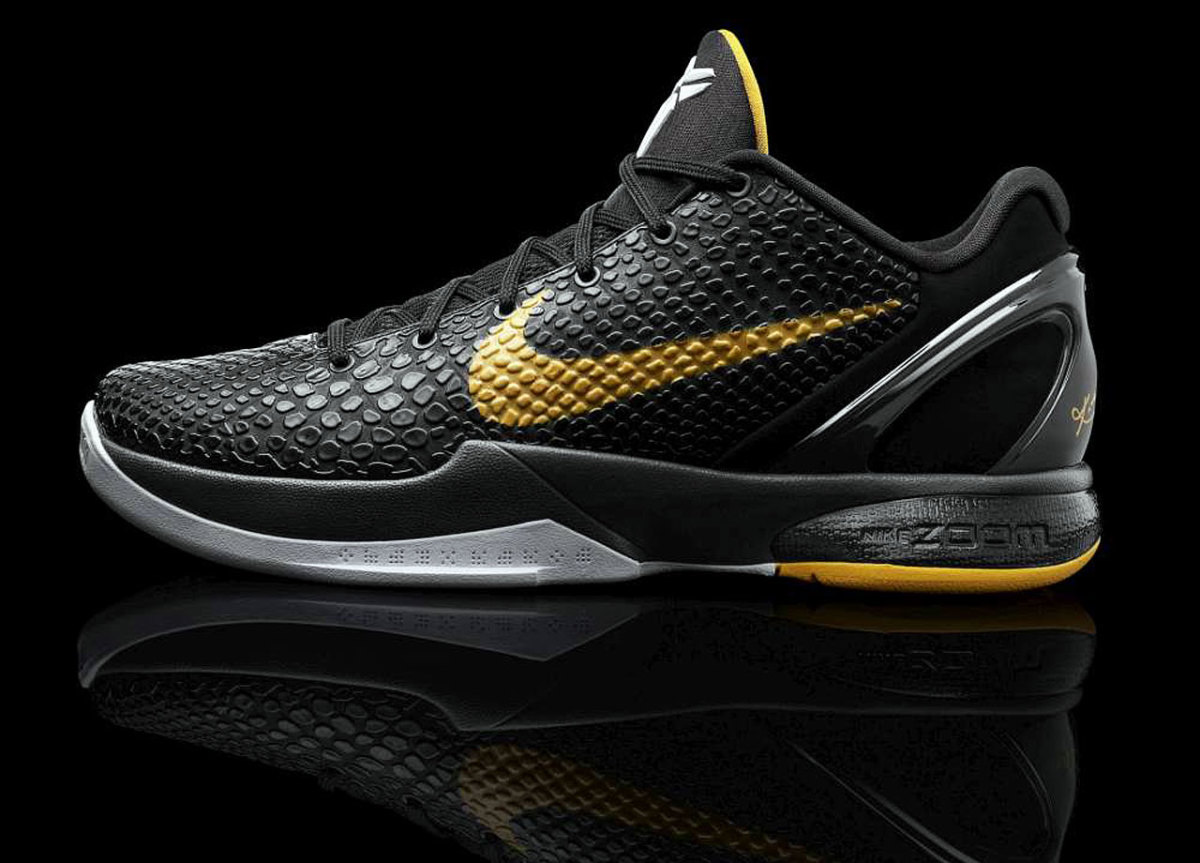
Nike calls them “islands,” the Black Mamba-inspired pieces of snake skin that increase or decrease in size to protect the durability of the shoe. The continued lightweight, low-cut design with Flywire upgraded in the late 2010 release of the VI with a new fit system that included a dual-layer memory foam sockliner conforming to the foot and an injected cushioning system. Nike Zoom Air units in the heel and forefoot added additional cushioning.
Zoom Kobe VII
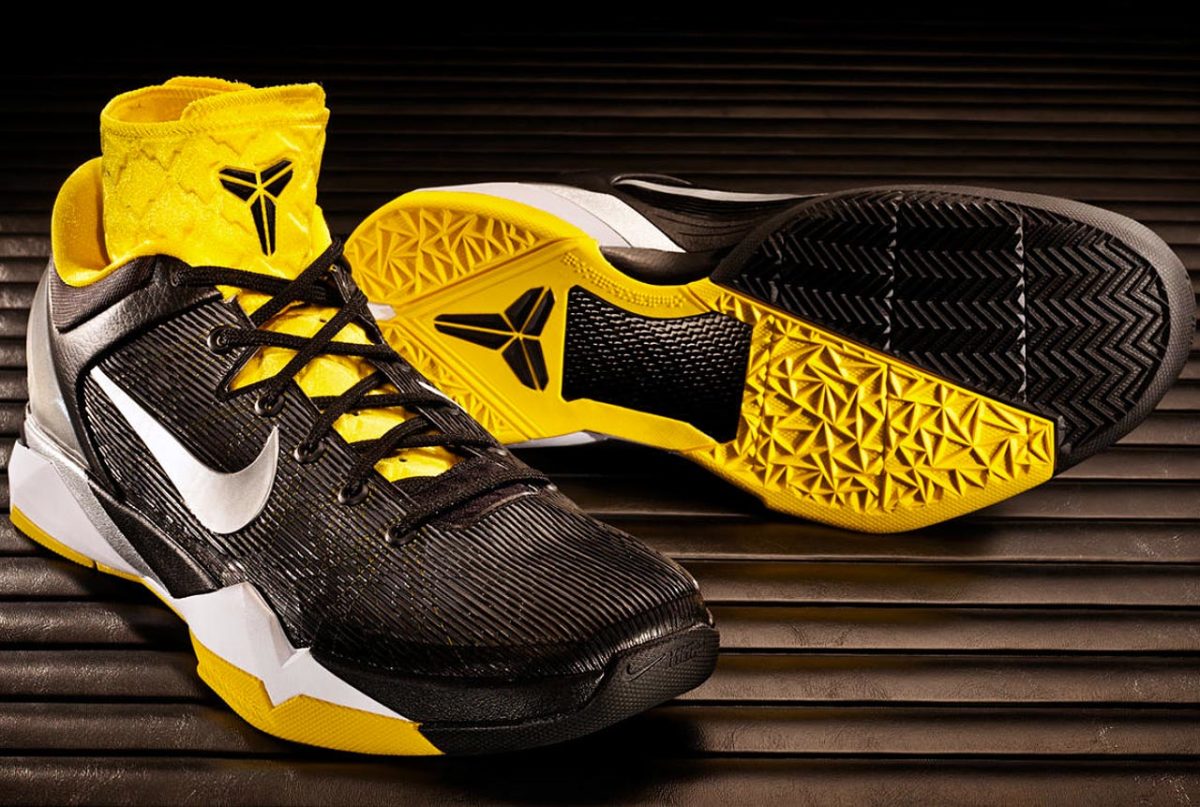
By late 2011, Nike was ready to customize the Kobe signature, offering cushioned inserts for either a lightweight focus or a more padded approach. Players were encouraged to switch back and forth as needed. The glass reinforced elements, Flywire and heel supports all went to the next generation of technology, while the aesthetic look focused on Kobe as a “predator.”
Zoom Kobe VIII
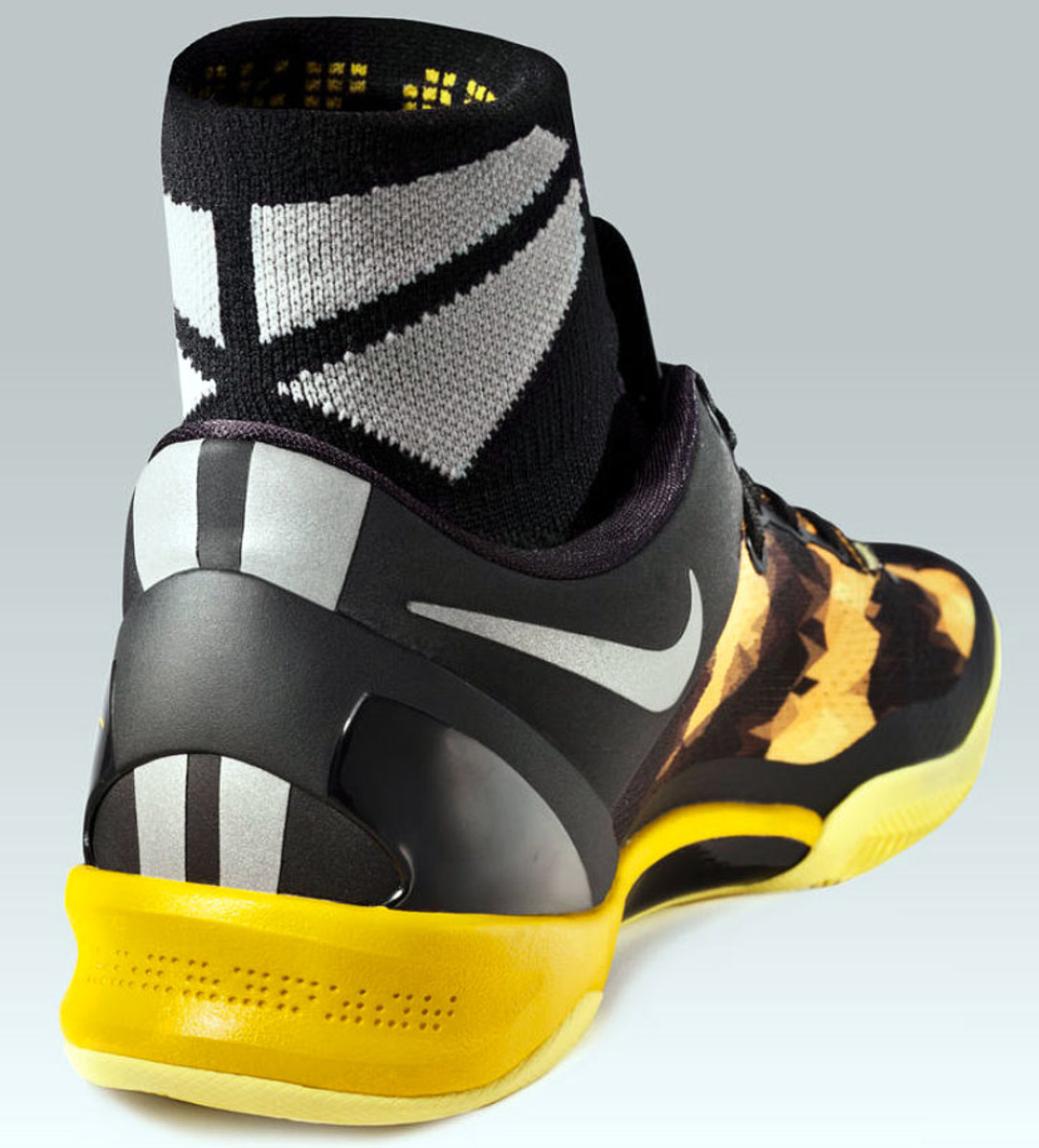
In December 2012, Nike went lower and lighter than ever before with a Kobe signature, using engineered mesh for the first time in a basketball shoe -- of course with a snakeskin pattern to go all Black Mamba on us -- to drop the weight of the VIII to 9.6 ounces. With 90 percent mesh and a no-sew construction, designers put more protective and supportive mesh where needed, while lightening and making other areas more breathable. A full-length Lunarlon midsole helped cushion against the thinnest outsole for a Kobe signature yet.
Zoom KOBE 9
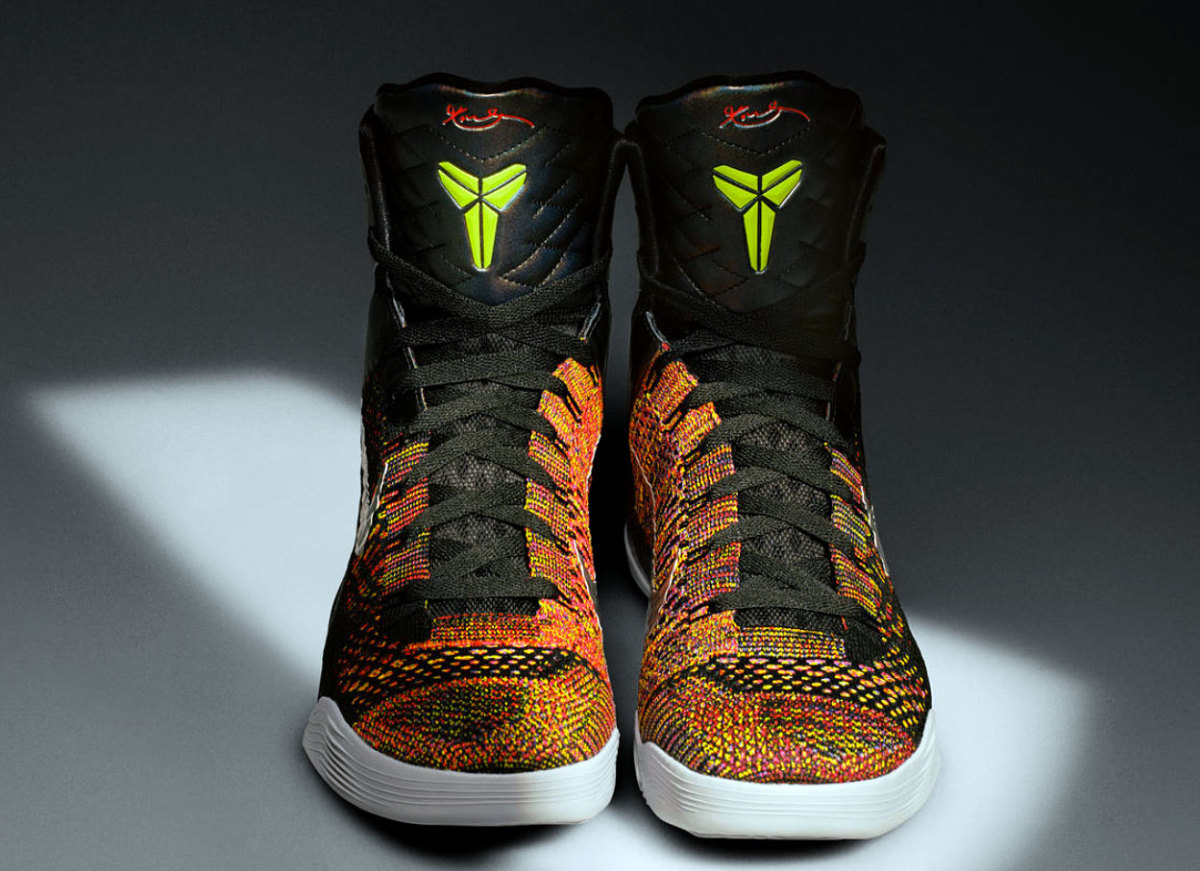
Forget low-cut. The KOBE 9 went ultra-high while unveiling Flyknit yarn for the first time in a basketball shoe when the shoe launched in February 2014. With Lunarlon introduced a year before and Flywire around for years, three key Nike technologies combine in the 9 to allow the much taller shoe to remain lightweight and supportive, yet still with the movement of a low-cut. The engineered yarn also let designers play with color.
Kobe X
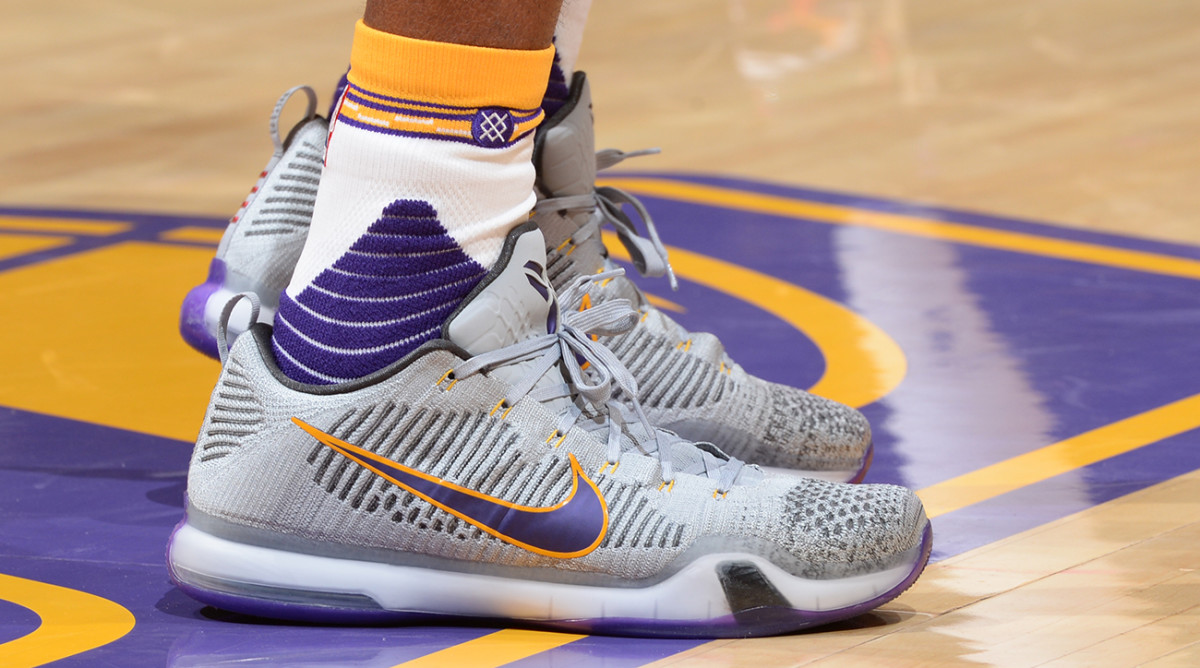
Kobe Bryant's tenth signature shoe featured hybrid cushioning, an advanced traction system and a seamless textile upper. At the time it was considered the most effective traction system in the history of Nike's basketball shoes.
Nike Kobe 11
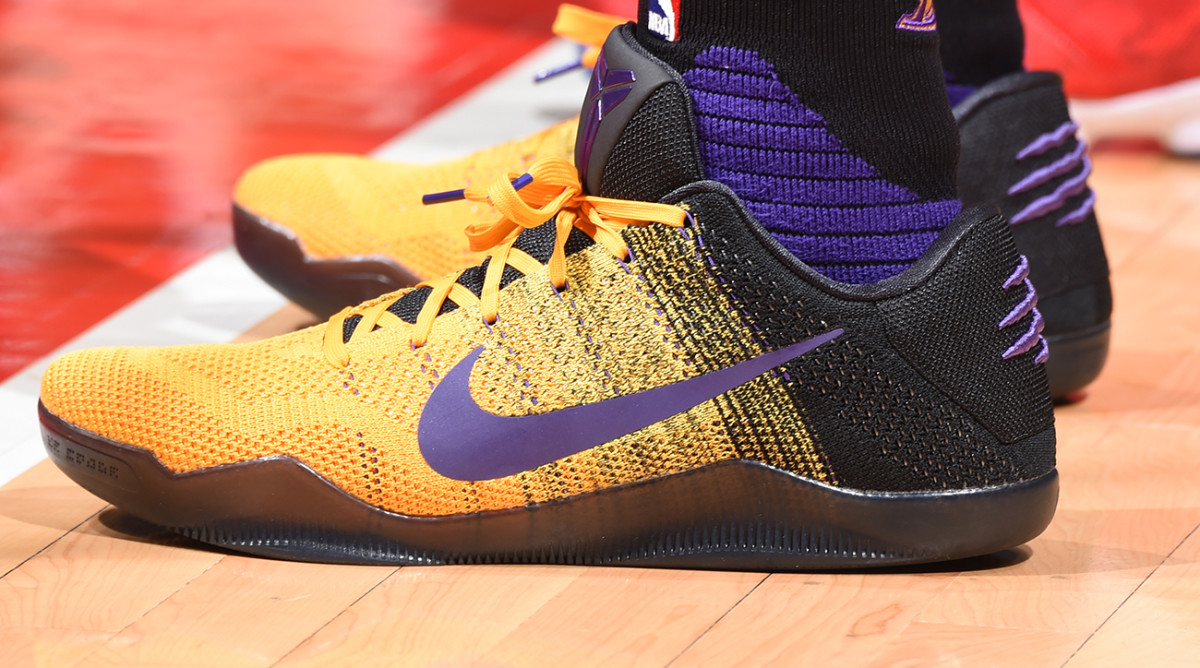
The Nike Kobe 11 was Bryant's final on-court shoe and the last numerical one in his signature line. The KOBE 11 is a progressive low-top that distills Bryant’s signature legacy to its essence: high performance, lightweight, responsive and sophisticated design.The Kobe 11 features Flyknit technology that includes thermoplastic polyurethane (TPU) yarn for superior strength, the brand’s first shoe to feature the new iteration of Flyknit.
Nike Kobe A.D.
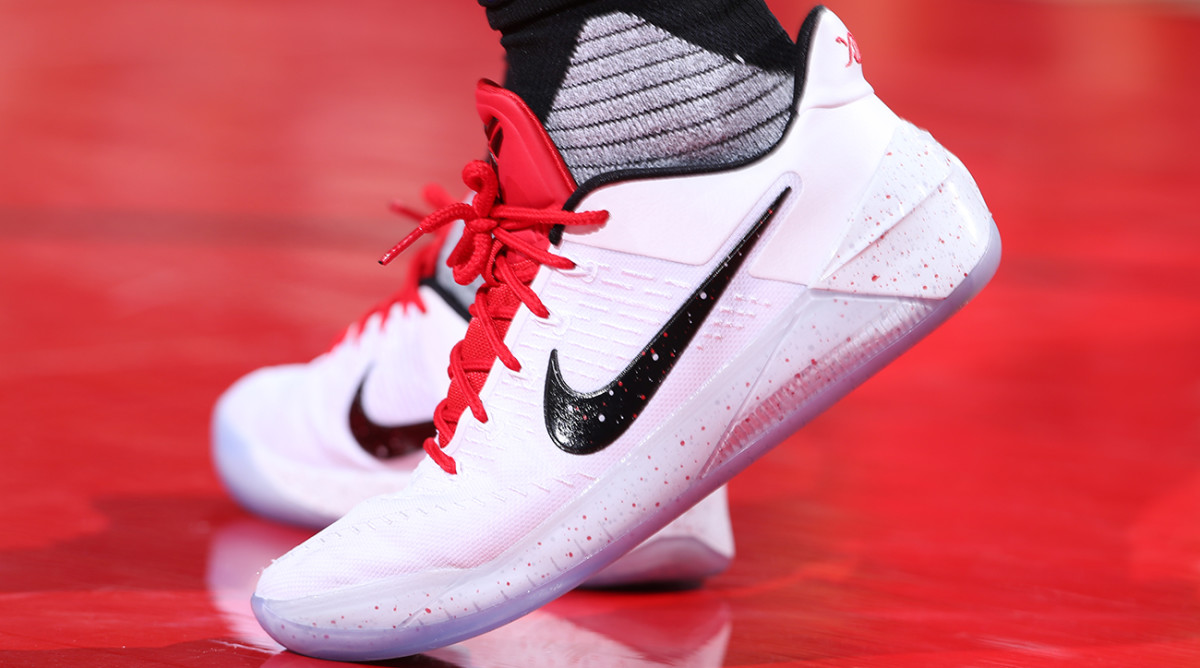
For Kobe's first post-retirement shoe, Nike introduced the Kobe A.D that follows the tradition of lightweight, low-profile on-court footwear. The sneaker combines a Zoom Air unit in the heel, Lunarlon foam in the midsole and a minimal rubber outsole. A breathable mesh upper with incorporated dynamic flywire, provided optimal lockdown.
Nike Kobe A.D. NXT
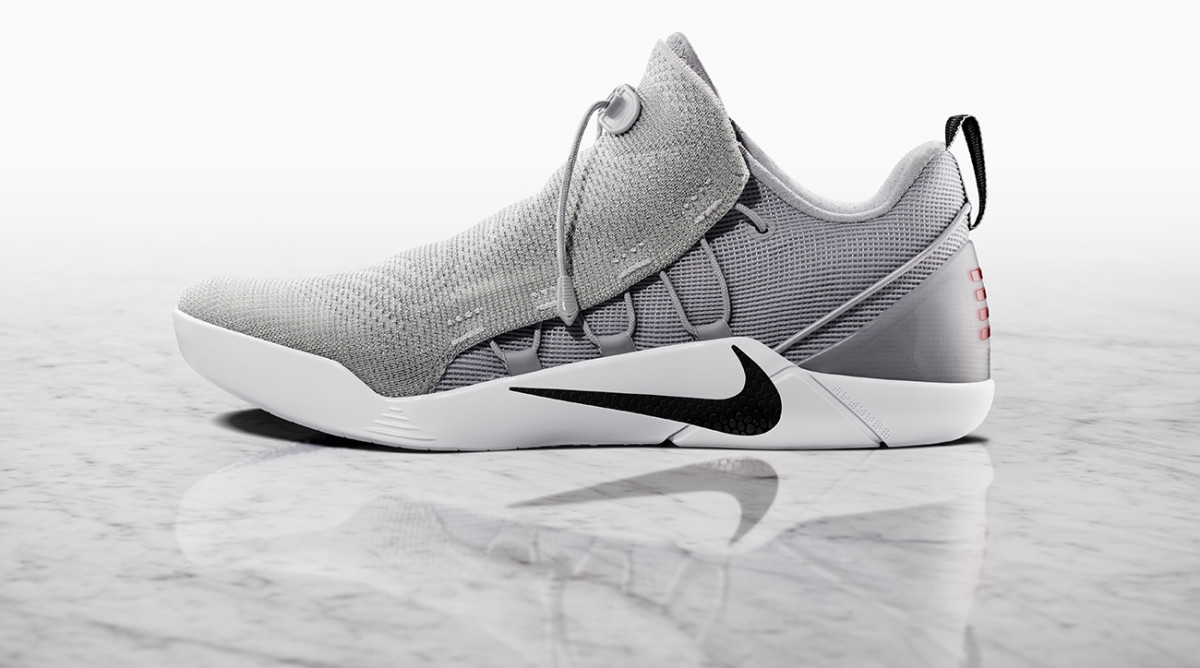
The Kobe A.D. NXT keeps the lightweight, low-profile characteristics of his signature line alive while adding a new layer to Bryant's endless innovation: a no-tie toggle lockdown system.
Nike Kobe A.D. Mid
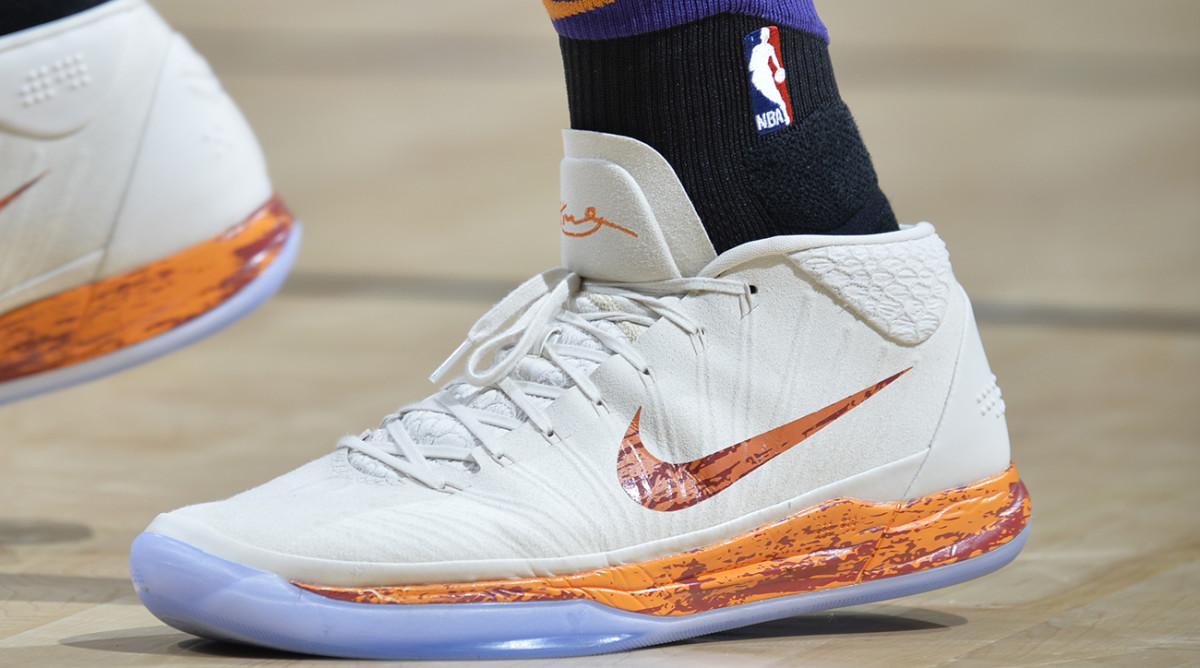
The Kobe A.D. Mid offers a multilayer upper provides a lightweight, ultra-thin feel that’s strong and supportive. Lunarlon foam combines with Zoom Air for soft yet responsive, cushioning. Engineered tread provides optimal traction for cutting and moving swiftly. He became a favorite among NBA stars DeMar DeRozan, Devin Booker and Isaiah Thomas.
Nike Kobe A.D. NXT 360
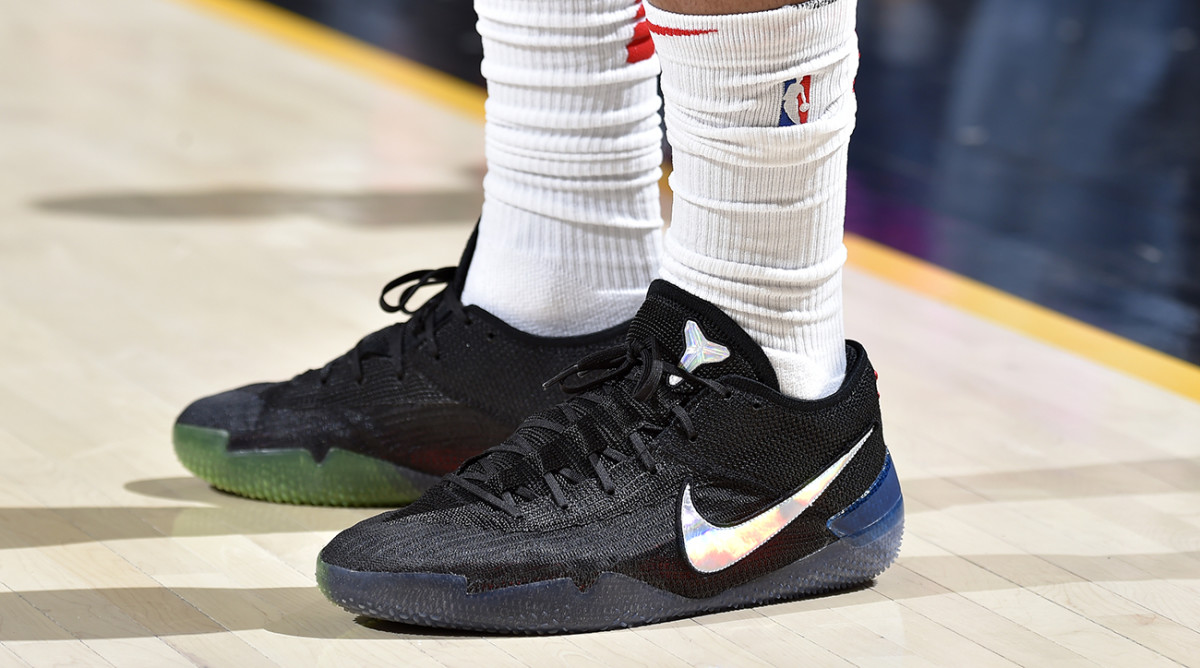
KOBE AD NXT 360 features a next generation Nike Flyknitupper that wraps the foot with 360-degree construction for a secure, second-skin fit. The shoe is equipped with a dual-density drop-in foam midsole made of Nike React technology and Lunarlon to maximize cushioning and response. DeMar DeRozan debuted the shoe on the court.
Nike Kobe A.D.
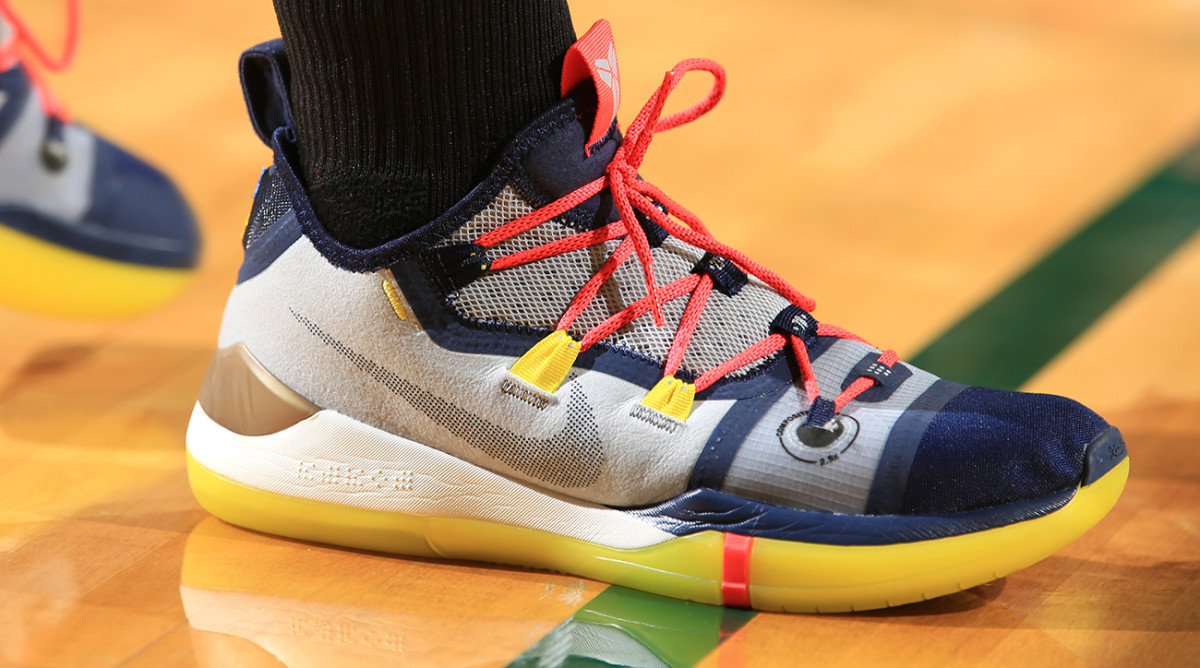
Debuted at the Nike Drew League, the latest Kobe A.D. features a has a full-length mesh bootie that supports the ability to stay locked in. It also features a Zoom Air Unit that fuels explosiveness and an engineered micro-blade outsole pattern that enhances traction.
“The gold sole, I’m not playing to be second, not playing to be third,” he said. “I’m not playing to be this close to number one; I want to be number one. When I put on those shoes and I walk, that is the path I’m walking down.”
But as he’s gotten older, No. 24 has taken a slightly different approach to his path. With more caution. Proceeding more gingerly. Early on, remaining low to the floor for quickness and speed was key to Kobe's game. Padding and support didn’t matter. “Now as I get older, cushioning becomes a real major aspect,” he said.
Kobe wanted to morph his love of low-to-the-floor quickness with his need for cushioning in the Kobe X. He clearly shows us his age-required importance on cushioning with a combination of air and foam cut to the movement of his foot. Cushioning doesn't matter much, though, without constant contact with the floor. Hundreds of tiny "nodules" make up a new grippy traction in the Kobe X. The nodules, new for a Nike basketball shoe, have proven so traction-oriented that Avar said they had to detune the grippy factor during testing. The forefoot and midfoot featureLunarlon cushioning, the lightweight yet resilient foam see in many Nike shoes, cut so that the foot can move naturally. The heel, though, contains a giant Zoom Air bag for intense cushioning. The combination of Lunarlon and Zoom Air is a unique twist for Bryant’s signature line.
Kobe Bryant on growing old, players he respects and finding his inner Zen
Staying with a low-top cut with engineered mesh on the upper helps cut down overall weight. While the Kobe 9 introduced Nike’s lightweight engineered yarn, Flyknit, to basketball in a super high-top, the X flips the script and returns Kobe to a lower form, although Avar reminds us that even the 9 saw low-top engineered mesh versions appear later and quite possibly Nike is simply “changing up that formula a little bit” for the roll-out of the X.
A carbon fiber wing helps with stabilization during those hard basketball cuts, giving high strength without much added weight. Avar said they moved the carbon fiber forward to allow the foot a more natural movement during those 90-degree cuts on a 45-degree angle.
Kobe said at this stage of his career he’s learned how to “make things work” on the floor, using different parts of his game as needed. It was the same with his 10th signature for Nike, combining bits and pieces of technology together. “Let’s take some of the most innovative technologies and morph them into one shoe,” he said. “Not supposed to work? Let’s make them work together.”
• MORE NBA: Kobe Longform: Final days of a legend (10.23.14)
Making sure the story, the design and the technology all mesh doesn’t bring Kobe in during the 11th hour. “I don’t know how other athletes go about doing it, I just so happen to love the process, love design, love storytelling,” he said. “I was crazy involved from the start. The first shoe we designed together, that process was insane.”
It started with Kobe, Avar, legendary shoe designer Tinker Hatfield and Nike CEO Mark Parker “sitting around throwing out ideas and concepts.” Originally, the team was transfixed with great white sharks and how they stealthily move and have a simple, slick design. There are even elements of the slick simplicity early on in Kobe's line. But eventually Kobe and Co. evolved and moved past the shark and straight to a snake, signifying his drive.
“The great thing about Kobe is that he is so direct, he is so honest,” Avar said. “He has a strong point of view, he has a strong voice. The public knows him as an incredibly intense, driven individual. He brings that to the creative process. His level of depth and intensity is by far off the charts.”
With a nine-month rehabilitation now facing him, the 5 AM FLIGHT colorway will continue to serve as a reminder that in order to build more on-the-floor snapshots for his future shoes, he has work to do off it. But no matter how much basketball Kobe has left, he doesn’t see leaving the world of hoops or sneakers anytime soon.
“It is kind of weird to talk about when players or athletes or people in general talk about retirement,” Kobe said. “What I learned from basketball, I continue to evolve those and apply those to other areas, apply those to my next passion.”
• MORE SNEAKERS: Nike unveils 'Black History Month' collection
And that will include continuing his line of shoes, saying he’s already looking forward to the 11th, 12th and 13th iterations. “Continue to build, continue to go,” he said as he flipped a basketball between hands. “I don’t set out to make a really hot shoe, I set out to make a product that is true to where I am.”
The sneaker snapshots have not come by accident. Kobe's line of signature shoes have purposefully told the story of his evolution. He’s always approached life philosophically. “That’s what happens to a kid who is 10 years old and has to read the Iliad cover to cover in Latin,” Bryant said. “You end up with a very philosophical perspective on things.”
Even sneakers.
Tim Newcomb covers stadiums, design and gear for Sports Illustrated. Follow him on Twitter at @tdnewcomb.
